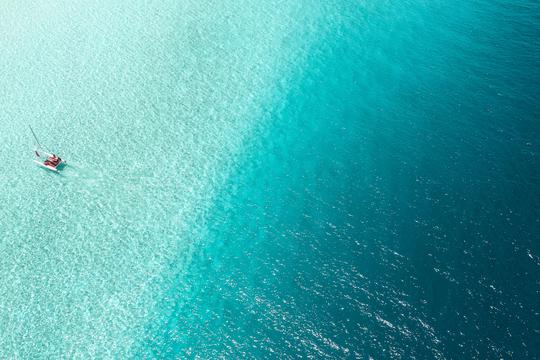
5 of the bluest places on Earth
Cheerful travel inspiration for a gloomy Blue Monday
India is a riot of color; a magical, mind-boggling place where desert forts rise from the dust, pilgrims flock to bathe in the sacred Ganges and tigers still roam free in the forests. Even the most experienced travellers are likely to feel out of their depth here – but that’s half the fun. Embrace the chaos and know that for every jam-packed overnight train journey and crowded Delhi market, there’s a palm-fringed beach, serene ashram or hilltop tea plantation with your name on it.
Visa requirements may change, for the most up-to-date information we recommend using our Entry Requirements tool. Alternatively, check the Indian embassy website in your country of departure.
Proof of a yellow fever vaccination will be required upon entry to India from a range of different countries.
Other recommended vaccinations include diphtheria, hepatitis a, hepatitis b, rabies, Japanese encephalitis, typhoid, and tetanus.
As advice can often change, you can check out our Entry Requirements tool for the most up-to-date details on vaccination requirements.
India is a vast country, so it really depends on where you are when it comes to the best time to visit. Generally though, October to February brings the most pleasant weather. March to June often becomes unbearably hot — particularly in Rajasthan and the central plains — and July to late September is the monsoon season, when downpours can be torrential.
Bear in mind that India is huge, so the weather will completely depend on where you are in the country at any given time. As an overview though, December to March sees warm and sunny temperatures with little to no rain across the country. April, May, and early June are baking hot and temperatures can sometimes soar to 48°C (118°F).
Most regions see the summer monsoon arrive from late June to September, with large areas of western and central India receiving more than 90% of their total annual rainfall. October onwards, the rainy season ends and temperatures are warm and pleasant.
However, the Himalayas see a completely different weather pattern. Temperatures from November to March can often be sub-zero, and snow doesn’t melt until around late March. April to June sees warm temperatures, clear skies, and little rain, while July, August, and September see temperatures soar.
It is customary in India to tip service providers such as waiters, at approximately 10%, depending on the service. Tipping is expected, though not compulsory, and shows an expression of satisfaction with the people helping you on your tour.
There are several times during the trip where there's an opportunity to tip the local guides or drivers we use. You may do this individually, or your CEO will offer to collect the money and tip as a group. Recommendations for tipping drivers and local guides would range from USD $1-2 per person, per day depending on the quality and length of the service.
Tipping your G Adventures CEO is also very much appreciated. The amount is entirely a personal preference; however, as a guideline, USD $20-30 per person, per week is our recommendation in the region. If you felt your CEO did an especially outstanding job, any additional amount is always welcome.
In large towns and cities, internet and Wi-Fi access tends to be fairly good in India. However, in rural areas like the Himalayas, be prepared for it to be more limited.
ATMs are widely available in large cities and towns, and both Visa and Mastercard are widely accepted. Check with your bank to see how much you may be charged for withdrawals — consider bringing cash in USD too. Major credit cards are accepted in most shops, but they may charge a 2-4% transaction fee.
As currency exchange rates can fluctuate often, we ask that you refer to www.xe.com for daily exchange rates.
LGBTQ+ rights are complex in India, and much of the country still remains fairly conservative — particularly in rural areas of the country. Use discretion and we’d recommend avoiding public displays of affection.
As part of their commitment, all CEOs receive LGBTQ+ inclusion training so every traveller feels respected and welcomed on all of our tours. We commit to making our tours a safe and inclusive place for people to express their authentic selves without judgment, free from any discriminatory language or harassment.
While travelling with G Adventures, all travellers must treat each other with dignity and respect to create an environment that is positive, safe, and where everyone feels welcome. You can find out more via our LGBTQ+ travel page.
There are 22 different officially-recognized languages spoken in India, ranging from Punjabi and Gujarati to Kashmiri and Bengali. The most widely-spoken languages are Hindi (spoken by over 500 million) and English.
In a word, no, tap water in India is never safe to drink. Bottled water is widely available and costs around 15-20 INR.
Please note, however, that all drinks provided on our tours are safe to drink (including drinks with ice), as well as the water in most hotels and restaurants visited on tour. If in doubt, please ask your CEO for further info.
India is generally a safe country to visit, and most people have no problems while there. However, it always pays to be aware of petty crime (like pickpocketing), tourist scams, and touts — particularly in larger cities.
Female travellers should also be aware that harassment, while uncommon, can sometimes occur. Dress modestly and always take a taxi if you’re travelling alone after dark.
G Adventures takes all reasonable measures to ensure your safety and enjoyment while travelling with us. All of the included activities are properly vetted and regularly checked by us, and we take great care in choosing the right transportation, stays throughout your trip, and guides to lead your tour. However, there are always inherent risks when travelling — you can find out more via our travel safety page.